| Article ID | Journal | Published Year | Pages | File Type |
|---|---|---|---|---|
| 5489415 | Journal of Crystal Growth | 2017 | 9 Pages |
Abstract
In directional solidification of silicon, the solid-liquid interface shape plays a crucial role for the quality of crystals. The interface shape can be influenced by forced convection using travelling magnetic fields. Up to now, there is no general and explicit methodology to identify the relation and the optimum combination of magnetic and growth parameters e.g., frequency, phase shift, current magnitude and interface deflection in a buoyancy regime. In the present study, 2D CFD modeling was used to generate data for the design and training of artificial neural networks and for Gaussian process modeling. The aim was to quickly assess the complex nonlinear dependences among the parameters and to optimize them for the interface flattening. The first encouraging results are presented and the pros and cons of artificial neural networks and Gaussian process modeling discussed.
Keywords
Related Topics
Physical Sciences and Engineering
Physics and Astronomy
Condensed Matter Physics
Authors
Natasha Dropka, Martin Holena,
